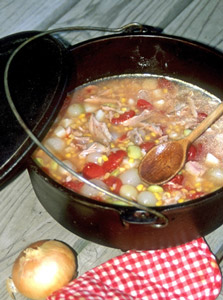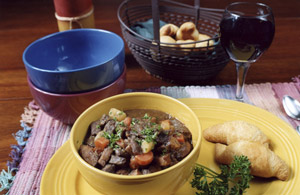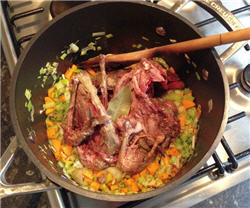
Try these five belly-warming stew recipes you can prepare using any wild game meat you have on hand.
For hundreds of years, a pot filled with stew simmering over a fire was one of the most practical ways to cook and share a meal. Today, one-pot dinners like stew — easy to prepare, simple to serve and perfect to make ahead — speak directly to our busy lives. Delicious, belly-warming stews never go out of style.
Bonus: Cooking with Brenda Valentine: Easy Venison Shoulder Roast - Video
Wild Game Stews vs Soups
Stews are dishes made of vegetables, meat, poultry and/or seafood cooked in a broth or sauce. The line between stew and soup is a fine one, but generally a stew's ingredients are cut in larger pieces and retain their individual flavors; a stew has thicker broth and less liquid; and a stew is more likely to be eaten as a main course than as a starter.
Soup is for folks who are not feeling well. You never hear, "I brought you some chicken stew for your cold." Stew is for more hearty appetites.
 Stewing is a great way to cook delectable dishes using all sorts of wild game. Ingredients can include almost any cut of meat, but stewing most often is used for tenderizing portions of older small-game animals or cuts of big game that tend to be tough.
Stewing is a great way to cook delectable dishes using all sorts of wild game. Ingredients can include almost any cut of meat, but stewing most often is used for tenderizing portions of older small-game animals or cuts of big game that tend to be tough.
A stew can be simmered in a pot on the stove top or campfire, cooked in a casserole dish in the oven or slow-cooked in a slow cooker.
Pick Your Stew Preparation Methods
When using the stove top or campfire method, I like to use a cast iron Dutch oven, which distributes heat evenly and allows the stew to simmer properly. This is the quickest way to make a stew, requiring only an hour or so of cooking time if you're in a hurry and use already-tender cuts of meat like tenderloin or young game animals. But if you have time and are attentive, stove-top cooking also can be used to tame tough cuts of gamy meat. Stir the stew often to prevent sticking, and be sure it always simmers, never boils. Higher heat from boiling will toughen the meat instead of tenderizing it. Ideally, your stew should bubble ever so slightly while cooking, and cooking should continue until the meat is fall-apart tender.
Although I seldom see folks use this method of preparation, stews also are well-suited for oven cooking in a casserole dish, clay pot or Dutch oven. Preheat the oven to 250 degrees. At this temperature, it is easy to keep the stew simmering below a boil. The meat doesn't toughen and takes less watching. And the resulting dish has a delicious flavor sure to please all your dinner guests. The stew is done when testing indicates the meat is tender and well cooked.
Whether cooking on top of the stove or in it, do not cover the cooking vessel tightly, or do not cover it at all. If sealed tightly in a pot, the liquid will quickly reach the boiling point and overcook the meat. If you use a lid to prevent spills, leave a small gap so steam can escape. The liquid then will simmer properly and produce more tender meat, even if the pot is on a 250-degree burner or in a 250-degree oven.
The exception to the tight-lid rule is when slow cooking in a slow cooker. This is my favorite method for preparing stew, as the food can cook all day without any attention and be ready to serve for an evening meal when a hungry crew gets home from work or a day in the field. Brown the meat, add it to the Crock-Pot with the other ingredients, stir, cover and cook on medium heat for 5 hours or low heat for about 8 hours.
Browning the meat is an important first step in stew preparation regardless of how you cook the dish. You may be tempted just to throw the game pieces into the pot and start stewing. This takes one step out of the preparation process and reduces the number of pots and pans you'll have to clean. But the chemical process that takes place when meat is browned in a bit of oil (called the "Maillard reaction," if you want to get all Julia Childs about it) seriously enriches the flavor of the dish. Browning also produces "fond," those delicious, crusty bits of browned meat in the bottom of the pan. Deglaze the pan by adding a little bit of water, wine or broth, and you have even more good stuff to add to your stew.
Many stews had their origins in Southern kitchens and included game in the ingredients. Gumbo, for example, is a hearty, spicy stew that originated in Cajun Louisiana where duck and goose were among the commonly used ingredients. Rabbit or squirrel was called for in the original Brunswick stew, which had its origins in Virginia and the Carolinas. Kentucky burgoo included whatever game was brought home from the hunt, including deer, opossum, squirrel and/or game birds.
Fact is, you can prepare stews using any game meat you have on hand. The following recipes are proof of that.
Brunswick Squirrel Stew Recipe
 |
| Brunswick Squirrel Stew |
- 4 squirrels, cut in serving pieces
- 3 quarts water
- 1/4 cup diced bacon
- 2 teaspoons fresh-ground black pepper
- 1/4 teaspoon cayenne pepper
- 1 tablespoon salt
- 1 cup pearl onions
- 2 cups peeled, whole tomatoes
- 2 cups diced potatoes
- 1 cup lima beans
- 2 cups whole-kernel corn
Place the squirrel and water in a large cooking pot. Bring to a boil, reduce heat and simmer 2 hours or until the meat is tender, skimming the surface occasionally. Remove the meat from the pot, allow to cool and separate the meat from the bones. Discard the bones and transfer the squirrel meat back to the liquid in the pot. Add all the remaining ingredients except the corn. Stir well. Cover and simmer for 1 hour. Add the corn and heat an additional 10 minutes. Yield: 10 to 12 servings.
Crock Pot Venison Stew Recipe
 |
| Venison Stew Over Noodles Photo by of All Recipes.com |
- 2 cups deer stew meat, cubed
- 2 tablespoons vegetable oil
- 1 (10-3/4-oz.) can condensed cream of mushroom soup
- 1 soup can water
- 1 cup diced onion
- 1 cup sliced fresh carrots
- 1/2 cup diced celery
- 1 tablespoon minced garlic
- 2 bay leaves
- 1/4 teaspoon crushed red pepper
- 2 teaspoons black pepper
- 2 tablespoons salt
- Dash Worcestershire sauce
Brown the venison in cooking oil heated in a skillet. Transfer the meat to a large Crock-Pot, add the remaining ingredients and stir. If necessary, stir in enough water so the liquid covers the meat and vegetables. Cover and cook on low 7 to 8 hours. Remove the bay leaves and serve over rice or noodles.
Stewed Goose Recipe
 |
| Stewed Goose. Photo by of Delta Waterfowl |
- 2 tablespoons vegetable oil
- 1 tablespoon minced garlic
- 1 large onion, chopped
- 2 celery stalks, sliced
- 4 boneless goose breast fillets, cut in bite-sized pieces
- 3 cups beef broth
- 3 large potatoes, cubed
- 3 carrots, sliced
- 1 tablespoon salt
- 2 teaspoons black pepper
- 1 teaspoon garlic powder
- Dash Worcestershire sauce
- Fresh parsley for garnish (optional)
In a large soup pot, heat the vegetable oil. Saute the garlic, onion and celery for 2 to 3 minutes over medium heat. Add the goose meat and continue to cook over medium heat until the meat is browned on all sides. Stir often to brown evenly.
Add the beef broth and bring to a boil. Reduce heat and simmer 1 hour. Add the potatoes, carrots, salt, pepper, garlic powder and Worcestershire sauce. Return to a boil then reduce heat and simmer for 30 to 45 minutes or until the vegetables are tender. Garnish with chopped fresh parsley. Serves 6 to 8.
Grandma's Rabbit Stew
 |
| Grandma's Rabbit Stew |
- 2 teaspoons salt
- 1 teaspoon freshly ground black pepper
- 1/2 teaspoon cayenne pepper
- 2 rabbits, cut in serving pieces
- 5 cups water
- 2 cups coarsely shredded cabbage
- 2 cups fresh or frozen whole-kernel corn
- 1 cup chopped onion
- 2/3 cup chopped green onions
- 1 cup diced potatoes, diced
- 1/2 cup peeled and sliced carrots
- 1/2 cup chopped canned tomatoes
- 1/4 cup green beans
- 1/4 cup chopped celery
- 1/4 cup tomato sauce
- 1/4 cup tomato paste
- 1/4 cup uncooked rice
- 1 clove garlic, minced
Combine salt, black pepper and cayenne, and season rabbit pieces. Brown the rabbit in vegetable oil heated in a large stew pot. Add the remaining ingredients, and stir well. Bring to a boil, then reduce heat and simmer, loosely covered, 2 to 3 hours or till rabbit and vegetables are tender. Makes 10 to 12 servings.
Stewed Grouse Recipe
 |
| Grouse Soup Photo by In Good Taste |
- 2 grouse, quartered
- 2 tablespoons flour
- 1 teaspoon salt
- 1/4 teaspoon black pepper
- 1/4 teaspoon onion salt
- 1/4 teaspoon celery salt
- 2 tablespoons bacon drippings or butter
- 2 medium onions, sliced thin
- 2 medium carrots, sliced thin
- 1/4 pound fresh mushrooms, sliced
- 1 bay leaf
- 6 link sausages, lightly browned
- 1 tablespoon bourbon (optional)
- 2 chicken bouillon cubes
- 1-1/2 cups boiling water
Dredge the grouse pieces in a combination of the flour and seasonings. Brown the pieces in a skillet in heated bacon drippings or butter. Line the bottom of a large buttered casserole dish with the sliced onions, carrots and mushrooms; place browned grouse on top of the vegetables. Add the bay leaf, sausages, bourbon and bouillon cubes dissolved in the boiling water. Cover loosely with a lid. Bake in a preheated 250-degree oven for about 2 hours, until the grouse is fork-tender. Stir well before serving. Yield: 4 to 6 servings.
Cooking With Brenda Valentine: Easy Venison Shoulder Roast
Cooking With Brenda Valentine: Easy Venison Shoulder Roast
- 21152 views

